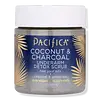What's inside
What's inside
 Key Ingredients
Key Ingredients

 Benefits
Benefits

 Concerns
Concerns

 Ingredients Side-by-side
Ingredients Side-by-side

Water
Skin ConditioningCetyl Alcohol
EmollientPrunus Armeniaca Seed Powder
AbrasiveGlycerin
HumectantGlyceryl Stearate Citrate
EmollientCharcoal Powder
AbrasiveMaranta Arundinacea Root Powder
Skin ConditioningCoco-Caprylate
EmollientHydrolyzed Verbascum Thapsus Flower
AntioxidantCocos Nucifera Oil
MaskingCamellia Sinensis Leaf Extract
AntimicrobialDecyl Glucoside
CleansingPotassium Cetyl Phosphate
EmulsifyingXanthan Gum
EmulsifyingDiheptyl Succinate
EmollientCapryloyl Glycerin/Sebacic Acid Copolymer
Skin ConditioningPhenoxyethanol
PreservativeEthylhexylglycerin
Skin ConditioningParfum
MaskingWater, Cetyl Alcohol, Prunus Armeniaca Seed Powder, Glycerin, Glyceryl Stearate Citrate, Charcoal Powder, Maranta Arundinacea Root Powder, Coco-Caprylate, Hydrolyzed Verbascum Thapsus Flower, Cocos Nucifera Oil, Camellia Sinensis Leaf Extract, Decyl Glucoside, Potassium Cetyl Phosphate, Xanthan Gum, Diheptyl Succinate, Capryloyl Glycerin/Sebacic Acid Copolymer, Phenoxyethanol, Ethylhexylglycerin, Parfum
Water
Skin ConditioningGlycerin
HumectantFarnesol
PerfumingSilica
AbrasiveCarbomer
Emulsion StabilisingCaprylic/Capric Triglyceride
MaskingOlea Europaea Fruit Oil
MaskingCharcoal
AbrasiveKaolin
AbrasiveTocopheryl Acetate
AntioxidantMalic Acid
BufferingHydrogenated Lecithin
EmulsifyingVanilla Planifolia Fruit Oil
EmollientXanthan Gum
EmulsifyingBenzyl Alcohol
PerfumingPotassium Sorbate
PreservativeSodium Benzoate
MaskingCitric Acid
BufferingAlternatives
Ingredients Explained
These ingredients are found in both products.
Ingredients higher up in an ingredient list are typically present in a larger amount.
Glycerin is already naturally found in your skin. It helps moisturize and protect your skin.
A study from 2016 found glycerin to be more effective as a humectant than AHAs and hyaluronic acid.
As a humectant, it helps the skin stay hydrated by pulling moisture to your skin. The low molecular weight of glycerin allows it to pull moisture into the deeper layers of your skin.
Hydrated skin improves your skin barrier; Your skin barrier helps protect against irritants and bacteria.
Glycerin has also been found to have antimicrobial and antiviral properties. Due to these properties, glycerin is often used in wound and burn treatments.
In cosmetics, glycerin is usually derived from plants such as soybean or palm. However, it can also be sourced from animals, such as tallow or animal fat.
This ingredient is organic, colorless, odorless, and non-toxic.
Glycerin is the name for this ingredient in American English. British English uses Glycerol/Glycerine.
Learn more about GlycerinWater. It's the most common cosmetic ingredient of all. You'll usually see it at the top of ingredient lists, meaning that it makes up the largest part of the product.
So why is it so popular? Water most often acts as a solvent - this means that it helps dissolve other ingredients into the formulation.
You'll also recognize water as that liquid we all need to stay alive. If you see this, drink a glass of water. Stay hydrated!
Learn more about WaterXanthan gum is used as a stabilizer and thickener within cosmetic products. It helps give products a sticky, thick feeling - preventing them from being too runny.
On the technical side of things, xanthan gum is a polysaccharide - a combination consisting of multiple sugar molecules bonded together.
Xanthan gum is a pretty common and great ingredient. It is a natural, non-toxic, non-irritating ingredient that is also commonly used in food products.
Learn more about Xanthan Gum